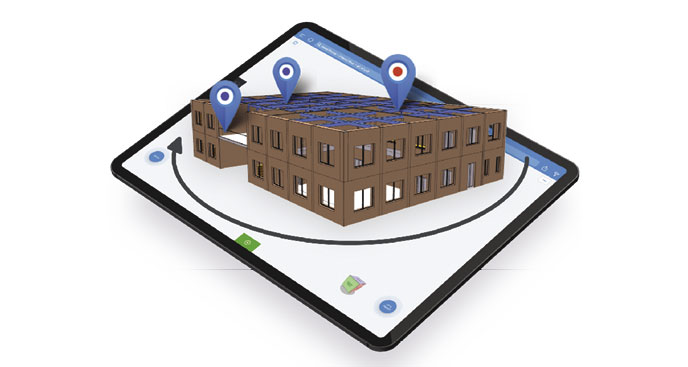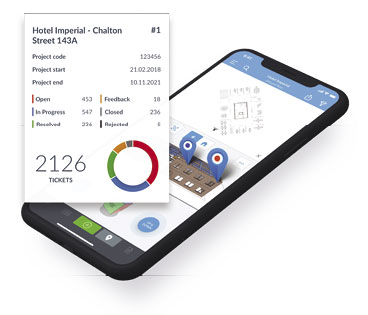 Ibrahim Iman the Co-CEO and Co-Founder of PlanRadar, describes how BIM for facilities management is not only an essential tool for the development of smart buildings, but is particularly valuable in the operational stage
Ibrahim Iman the Co-CEO and Co-Founder of PlanRadar, describes how BIM for facilities management is not only an essential tool for the development of smart buildings, but is particularly valuable in the operational stage
Since the UK Government mandated the use of level 2 BIM (Building information modelling) for all public-sector constructions in April 2016, BIM has grown to become a very important tool for architects and contractors in the design and construction of new buildings. According to a new government report, BIM is a key tool that will be used to digitise the built environment because it provides the most detailed analytical view of a built asset during the design and construction of a project.
With its collaborative model for shared working for all stakeholders in a building’s design and operation, it’s easy to see why BIM’s popularity has increased so much in recent years. It provides a single source of truth in a tangible format. Unfortunately, so far, relatively few facilities management teams are using BIM. This is despite the fact that the benefits of BIM are not limited to construction and that most of BIM’s success stories are due to operational benefits. A PwC report into two government projects showed that while BIM generated savings of up to three per cent over the total life cost of the projects, 70 per cent of the benefits were seen in the operation phase. It shows that by creating more robust common data environments, there is the potential to generate further savings in the operations phase.
THE BENEFITS OF BIM FOR FM
 So, what are the benefits of BIM for facilities management, and how can facilities managers access them?
So, what are the benefits of BIM for facilities management, and how can facilities managers access them?
The benefits of BIM start before the building transfer to facilities management teams because it can bring the team together to collaborate on the building during construction. If facilities managers can have more input when it comes to the design, it can have a huge impact on operating efficiency, usability, and security. When a building is completed, the contractor should pass over the BIM model to the facilities manager as part of the as-built documentation. This digital twin, sometimes called the asset information model (AIM), should contain all information relating to the building, its construction, and every asset. This 3D model becomes the blueprint for the building and its management.
With all the data in one place, the model operates as the single source of truth, with the “golden thread” of all actions and decisions safely stored. The digital file eliminates the need for paperwork and duplicates, as all the information can be attached to the 3D design. Asset data can be included as part of the model, with the documentation attached to its location in the digital twin.
BIM also provides a safe place for testing. New layouts can be tried with trouble-shooting and design modifications all tested and signed off in the digital twin before they are implemented in the real world. Linking the model to facilities management software reduces the time needed to locate faults and automatically schedule maintenance or arrange for repairs.
NEXT GENERATION FACILITY MANAGEMENT SOFTWARE IS BIM READY
The most advanced facility management software now comes integrated with BIM ready for managers to use. Normally, facility managers will not need more than a smartphone, laptop or tablet to access and manage the building. Using the BIM viewer, users can view 3D digital versions of assets, and store and locate all relevant data relating to them in the model. This includes linking installation dates, materials used and the manufacturer’s information. This saves time and makes life easier for the contractor to find faults and fix them.
 When facility management software is integrated with BIM, users can mark defects and audit failures directly on the BIM model and automatically send tickets to the relevant contractors. Tickets can include any additional documentation, images of the problem, or written or audio notes. These can be sent with deadlines which will produce push notifications for senior managers when the work is complete or the status changes.
When facility management software is integrated with BIM, users can mark defects and audit failures directly on the BIM model and automatically send tickets to the relevant contractors. Tickets can include any additional documentation, images of the problem, or written or audio notes. These can be sent with deadlines which will produce push notifications for senior managers when the work is complete or the status changes.
With the BIM model fully integrated into the facility management software, it is the heart of the one place where all maintenance, operation and repair activity is performed.
PAVING THE WAY FOR DIGITISATION
What makes a building smart is the way its core systems connect and “communicate” with one another, from the water meters to the lighting. The main features of these buildings will intelligently work to help reduce the expenses of the building for managers. Sensors can be used to monitor footfall and turn off lights or heating in unused rooms, while collecting data for managers on which parts of the building are being used and helping to allocate resources accordingly. Smart buildings generate lots of valuable data, which will be key to finding more valuable ways to save energy and improve efficiency.
The Crystal building situated in the Royal Docks in London is an example of one of the world’s smartest and most sustainable buildings. It’s 100 per cent electric and has solar panels on the roof that heat its recycled water, as well as generating about 20 per cent of its power. Its building energy management system controls all the mechanisms in the building, monitoring its usage and even accesses information from an outdoor weather station to influence its heating, air-conditioning and ventilation systems. High performance solar glass allows natural light into almost every area of the building, while sensors monitor outdoor and indoor conditions to adjust internal brightness levels or turn the lights off entirely if needed. As a result, The Crystal’s carbon emissions are about 70 per cent lower than similar buildings in the UK.
Smart buildings like this are the future. One day soon, we will live and work in buildings that will provide continuous feedback on assets and efficiencies. In time, facilities managers will be able to stress-test different settings and layouts on a digital twin. Using information technology, these buildings will connect a variety of subsystems, share information and optimise the buildings total performance. Lighting, heating, ventilation, air- conditioning, security devices and specialist assets will all be controlled in the digital environment.
This transition will help realise greater efficiencies in the operational phase, reduce the impact on the environment and reduce the significant operating costs that building owners currently face. With automation and data feedback, facilities managers can make intelligent, information-based decisions to improve the safety, security and comfort of buildings for its users.
The evolution of digital buildings has already started, and its green shoots are in BIM. With continued progress, facilities managers will be able to automate more processes and generate further efficiency gains.




